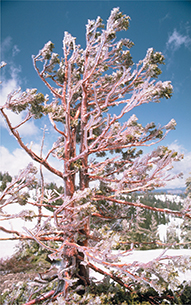Forms of Precipitation
Precipitation occurs when water droplets or ice crystals in clouds join together and become large enough to fall to the ground without evaporating. Clouds are the source of all precipitation.  The most common types of precipitation are rain, snow, hail, sleet, and freezing rain.
The most common types of precipitation are rain, snow, hail, sleet, and freezing rain.
Rain and Snow
Rain is liquid precipitation that usually forms in either nimbostratus clouds or cumulonimbus clouds. Snow is precipitation in the form of ice crystals called snowflakes. The size and shape of snowflakes depend on the temperature at which they form.
Figure 18 Freezing rain creates beautiful effects but can be dangerous.

Hail, Sleet, and Freezing Rain
Hail is precipitation in the form of round, solid pieces of ice more than 5 millimeters in diameter. Hail forms within cumulonimbus clouds when small ice pellets are tossed up and down by rising and falling air. As the ice is tossed about, it collides and combines with water droplets that then freeze, creating more and more layers of ice. Eventually, the ice becomes heavy enough to fall to the ground as hail. Hail can sometimes cause tremendous damage to crops, vehicles, and buildings.
Sleet is precipitation in the form of ice particles that are usually smaller than 5 millimeters in diameter. Sleet is rain that freezes as it falls. Sleet rarely damages crops or vehicles directly, but it can make driving extremely hazardous.
Freezing rain is rain that freezes after hitting the surface. Freezing rain produces beautiful effects, as Figure 18 shows, but it can be dangerous. Roads become very slippery, and branches or power lines can fall from the weight of the ice.
Section 24.4 Assessment
Reviewing Concepts
 List the ways in which water vapor condenses in the atmosphere.
List the ways in which water vapor condenses in the atmosphere. Explain how clouds form.
Explain how clouds form. Describe each of the three main cloud forms.
Describe each of the three main cloud forms. What are the most common types of precipitation?
What are the most common types of precipitation?
Critical Thinking
Classifying A winter storm produced precipitation in the form of ice particles that averaged about 4 millimeters in diameter. What kind of precipitation was it?
Applying Concepts Suppose the dew point of the air in your area is 20°C. The temperature outside is supposed to drop from 25°C to about 15°C by midnight. What weather condition will probably occur by morning? Explain why.
Connecting Concepts
Condensation Use what you learned about phase changes and condensation in Section 3.3 to explain how clouds form.




